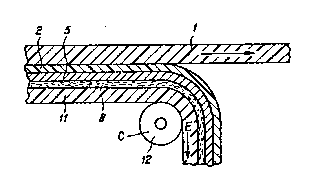Some of the information on this Web page has been provided by external sources. The Government of Canada is not responsible for the accuracy, reliability or currency of the information supplied by external sources. Users wishing to rely upon this information should consult directly with the source of the information. Content provided by external sources is not subject to official languages, privacy and accessibility requirements.
Any discrepancies in the text and image of the Claims and Abstract are due to differing posting times. Text of the Claims and Abstract are posted:
| (12) Patent Application: | (11) CA 2067731 |
|---|---|
| (54) English Title: | METHOD FOR EMBOSSING HOLOGRAMS |
| (54) French Title: | METHODE D'EMBOSSAGE D'HOLOGRAMMES |
| Status: | Deemed Abandoned and Beyond the Period of Reinstatement - Pending Response to Notice of Disregarded Communication |
| (51) International Patent Classification (IPC): |
|
|---|---|
| (72) Inventors : |
|
| (73) Owners : |
|
| (71) Applicants : | |
| (74) Agent: | SMART & BIGGAR LP |
| (74) Associate agent: | |
| (45) Issued: | |
| (86) PCT Filing Date: | 1990-11-29 |
| (87) Open to Public Inspection: | 1991-06-13 |
| Examination requested: | 1997-10-28 |
| Availability of licence: | N/A |
| Dedicated to the Public: | N/A |
| (25) Language of filing: | English |
| Patent Cooperation Treaty (PCT): | Yes |
|---|---|
| (86) PCT Filing Number: | PCT/NL1990/000179 |
| (87) International Publication Number: | WO 1991008524 |
| (85) National Entry: | 1992-04-09 |
| (30) Application Priority Data: | ||||||
|---|---|---|---|---|---|---|
|
2067731 9108524 PCTABS00005
In a method for producing a material embodying an interference
pattern, for example a holographic image, the interference pattern
is introduced into a transparent release layer (2) situated on a
plastic basefilm (1), by forming said pattern in the release
layer (2), applying the substrate (11) onto the finished release
layer (2) and removing the substrate (11) together with the release
layer (2) from the plastic base film (1). In a first embodiment,
the plastic base film (1) is embossed with the interference
pattern and the transparent release layer (2) is then applied to the
embossed side of the plastic base film (1). In a second embodiment,
the transparent release layer (2) is applied to the plastic base
film (1) and the transparent release layer is then embossed with
the interference pattern.
Note: Claims are shown in the official language in which they were submitted.
Note: Descriptions are shown in the official language in which they were submitted.

2024-08-01:As part of the Next Generation Patents (NGP) transition, the Canadian Patents Database (CPD) now contains a more detailed Event History, which replicates the Event Log of our new back-office solution.
Please note that "Inactive:" events refers to events no longer in use in our new back-office solution.
For a clearer understanding of the status of the application/patent presented on this page, the site Disclaimer , as well as the definitions for Patent , Event History , Maintenance Fee and Payment History should be consulted.
| Description | Date |
|---|---|
| Inactive: IPC from MCD | 2006-03-11 |
| Inactive: IPC from MCD | 2006-03-11 |
| Application Not Reinstated by Deadline | 2001-11-29 |
| Time Limit for Reversal Expired | 2001-11-29 |
| Deemed Abandoned - Conditions for Grant Determined Not Compliant | 2001-03-05 |
| Deemed Abandoned - Failure to Respond to Maintenance Fee Notice | 2000-11-29 |
| Notice of Allowance is Issued | 2000-09-05 |
| Letter Sent | 2000-09-05 |
| Notice of Allowance is Issued | 2000-09-05 |
| Inactive: Approved for allowance (AFA) | 2000-08-21 |
| Amendment Received - Voluntary Amendment | 2000-07-24 |
| Letter Sent | 2000-04-26 |
| Letter Sent | 2000-04-26 |
| Inactive: Single transfer | 2000-03-21 |
| Inactive: S.30(2) Rules - Examiner requisition | 2000-01-24 |
| Inactive: Application prosecuted on TS as of Log entry date | 1997-12-02 |
| Inactive: RFE acknowledged - Prior art enquiry | 1997-12-02 |
| Inactive: Status info is complete as of Log entry date | 1997-12-02 |
| All Requirements for Examination Determined Compliant | 1997-10-28 |
| Request for Examination Requirements Determined Compliant | 1997-10-28 |
| Application Published (Open to Public Inspection) | 1991-06-13 |
| Abandonment Date | Reason | Reinstatement Date |
|---|---|---|
| 2001-03-05 | ||
| 2000-11-29 |
The last payment was received on
Note : If the full payment has not been received on or before the date indicated, a further fee may be required which may be one of the following
Please refer to the CIPO Patent Fees web page to see all current fee amounts.
| Fee Type | Anniversary Year | Due Date | Paid Date |
|---|---|---|---|
| MF (application, 7th anniv.) - standard | 07 | 1997-12-01 | 1997-10-03 |
| Request for examination - standard | 1997-10-28 | ||
| MF (application, 8th anniv.) - standard | 08 | 1998-11-30 | 1998-09-29 |
| MF (application, 9th anniv.) - standard | 09 | 1999-11-29 | 1999-11-02 |
| Registration of a document | 2000-03-21 | ||
| MF (application, 2nd anniv.) - standard | 02 | 1992-11-30 |
Note: Records showing the ownership history in alphabetical order.
| Current Owners on Record |
|---|
| AMSTERDAM METALLIZED PRODUCTS B.V. |
| Past Owners on Record |
|---|
| EDWARD JOHANNES VAN DER LAAN |
| GIJSBERTUS VAN SUYLEKOM |